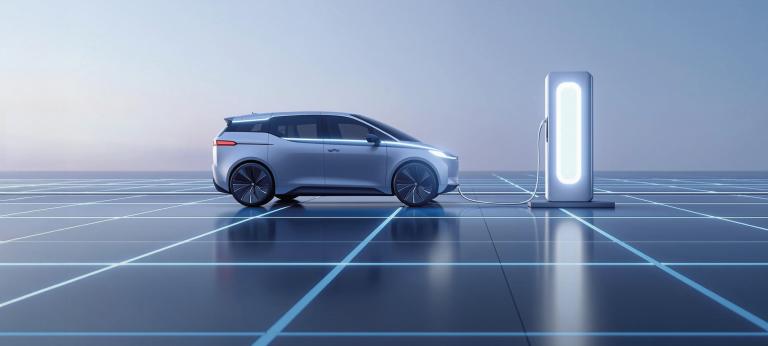EV Charging Index 2025: Steady progress
Despite tough market conditions, global EV use and charging infrastructure showed continued steady growth in 2024. Learn more in Roland Berger’s latest EV Charging Index.


Italy edged up our rankings in the 2025 Index but remains near the bottom of the pack. EV sales fell slightly following policy uncertainty, but charging infrastructure showed solid growth. Financial incentives remain key to improving EV sales penetration.

EV sales experienced a challenging year in Italy, with a decrease of approximately 8% in new vehicle sales following policy uncertainty and a general downturn in the auto market. ICE vehicle registrations also suffered in 2024, ensuring Italy's EV sales penetration rate remained relatively stable at 8% – still well below the European average of 25%. Early signs in 2025 show that EV sales rates are rising again, thanks in part to a growing selection of entry-level EVs.
Geographic disparities persist, with northern Italy accounting for around 60% of BEV sales, followed by central Italy, while the south lags behind.
The pace of expansion in Italy's EV parc is still far below the levels needed to meet the government's 2030 target of approximately six million vehicles. At its current growth rate, the country's EV parc would be roughly halfway below the policy goal.
In contrast to the difficulties faced with EV sales, Italy's charging network continues to show solid growth: public and private infrastructure combined recorded a CAGR of 68% between 2021 and 2024. Public charging infrastructure grew 28% in 2024, and the ratio of EVs to public charge points improved from 19 to 17, although this is partly down to the decrease in EV sales. This ratio is slightly inferior to the European average of 14.
The proportion of fast chargers continues to rise, with almost one in four public charge points now DC (22%), up from 14%. This reflects growing demand for rapid charging solutions, especially for long-distance travel and highway use, where approximately 60% of chargers exceed 150 kW.
"The slowdown of electric mobility is putting the business model of major operators under pressure. Selecting the proper technology and locations will be key to securing sustainable returns on capital employed."
The slower-than-expected expansion of Italy's EV parc is putting pressure on charge point operators, who have invested expecting quicker returns. Location selection is emerging as a critical driver of operator performance, with trends and deviations from forecasts differing widely across regions.
As with EV sales, the distribution of charging infrastructure across Italy is uneven: roughly 55% of charge points are concentrated in northern Italy, while central and southern regions are less well served but growing rapidly.
EV purchasing incentives remain a key tool in supporting Italy's e-mobility transition: 42% of respondents to our survey reported that tax benefits, subsidies and policy requirements were among their main reasons for purchasing an EV.
However, the absence of a renewed Ecobonus for BEV purchases in 2025 could slow progress at a critical moment for the sector.
On the other hand, the fringe benefit reform increased the tax burden on corporate long-term rental of ICE vehicles and is expected to have a positive effect on the electrification of corporate fleets.
Incentives are also important for infrastructure development, with subsidies available for the installation of both public and private charge points.
Despite the improvement in Italy's public charging infrastructure, half of respondents say the public charging network remains inefficient and charge times are too slow. The government has allocated funds to support the installation of high-power charging stations in urban and extra-urban areas, while grants and tax benefits are available to individuals, businesses and condominiums looking to install private charge points.
"Public transport electrification targets are ambitious but achievable – providing infrastructure partners accelerate deployment alongside fleet replacements."
Italy's charging infrastructure expansion is partly being driven by the entry of new players to the market. In early 2025, Mobilize, Renault Group's mobility brand, acquired a significant stake in Free To X, the EV charging subsidiary of Autostrade per l'Italia, with the aim of building more high-power charging stations in urban and regional areas.
Elsewhere, IP Group and Macquarie Capital created the joint venture IPLANET to install fast and ultrafast EV charging stations at over 500 service stations across Italy by 2032. Atlante (a joint venture led by NHOA), Ewiva (a partnership between Enel X Way and Volkswagen Group) and Powy (an Italian scale-up also active in Spain) have also joined the market.
Italy has set ambitious targets for electrifying its fleet of public buses, with electric bus adoption currently below roughly 2%. There are around 43,000 buses in operation across the country, with an average age of over 10 years. At least 15,000 buses will need to be replaced within the next decade due to aging fleets and compliance requirements.
The government is aiming for approximately 20% of new buses to be electric by the end of 2025 and around 30% by 2030. Funds have already been allocated for more than 3,000 electric buses and related infrastructure.
Specific players such as E-GAP have emerged to serve this segment with dedicated infrastructure development and charging management systems.
Register now to to discover the latest insights, emerging trends and upcoming challenges in the EV and EV charging markets.